#anime North 2016
Text

SUMMARY: A man bumps into an old crush and holds her captive underneath the animal shelter where he works.
Not even Dominic Monaghan is enough for the mod to watch this movie. It does have some very interesting ideas though.
#pet (2016)#psychological horror#kidnapping#2010s#united states#north american movie#mentionable warning#animal death#horror#movie#poll#more than 50% havent heard
65 notes
·
View notes
Text
posting this now before the 25th so I cam say I technically did smth for Christmas. You're welcome

Buster: thanks you guys, this is the most presents I've *ever* gotten!
Rosita: seriously? How many presents do you get every year?
Buster: not including my self given gifts, 1! (The one obviously being from Ms Crawly)
Rosita: aww, Buster...(sympathetically)
Ash: who's your favourite artist? (Ash has connections and she will use those connection to make her dad happy)
Mike: yeah I want to make a bank withdrawal for somebody...no I'm not drunk
Johnny: *already gone to the nearest store at the speed of light*
#Poor little koala man thing never got a proper Christmas#His adopted family travel to the North Pole to throw hands with Santa Clause#Anyways Merry Christmas#Now get outta here you filthy animals (home alone reference)#sing 2016#sing movie#sing buster#buster moon#sing rosita#Rosita#sing mike#mike the mouse#johnny sing#Johnny#ash sing#Ash#Not so ugly drawings I actually really like this
103 notes
·
View notes
Text
"In one of Africa’s last great wildernesses, a remarkable thing has happened—the scimitar-horned oryx, once declared extinct in the wild, is now classified only as endangered.
It’s the first time the International Union for the Conservation of Nature (IUCN), the world’s largest conservation organization, has ever moved a species on its Red List from ‘Extinct in the Wild’ to ‘Endangered.’
The recovery was down to the conservation work of zoos around the world, but also from game breeders in the Texas hill country, who kept the oryx alive while the governments of Abu Dhabi and Chad worked together on a reintroduction program.
Chad... ranks second-lowest on the UN Development Index. Nevertheless, it is within this North African country that can be found the Ouadi Rimé-Ouadi Achim Faunal Reserve, a piece of protected desert and savannah the size of Scotland—around 30,000 square miles, or 10 times the size of Yellowstone.
At a workshop in Chad’s capital of N’Djamena, in 2012, Environment Abu Dhabi, the government of Chad, the Sahara Conservation Fund, and the Zoological Society of London, all secured the support of local landowners and nomadic herders for the reintroduction of the scimitar-horned oryx to the reserve.
Environment Abu Dhabi started the project, assembling captive animals from zoos and private collections the world over to ensure genetic diversity. In March 2016, the first 21 animals from this “world herd” were released over time into a fenced-off part of the reserve where they could acclimatize. Ranging over 30 miles, one female gave birth—the first oryx born into its once-native habitat in over three decades.
In late January 2017, 14 more animals were flown to the reserve in Chad from Abu Dhabi.
In 2022, the rewilded species was officially assessed by the IUCN’s Red List, and determined them to be just ‘Endangered,’ and not ‘Critically Endangered,’ with a population of between 140 and 160 individuals that was increasing, not decreasing.
It’s a tremendous achievement of international scientific and governmental collaboration and a sign that zoological efforts to breed endangered and even extinct animals in captivity can truly work if suitable habitat remains for them to return to."
-via Good News Network, December 13, 2023
#chad#abu dhabi#north africa#rewilding#endangered species#conservation#zoology#conservation biology#oryx#good news#hope#texas#big game#animals#endangered#environmentalism#environmental science#zoo#zoos#zoo animals
24K notes
·
View notes
Text
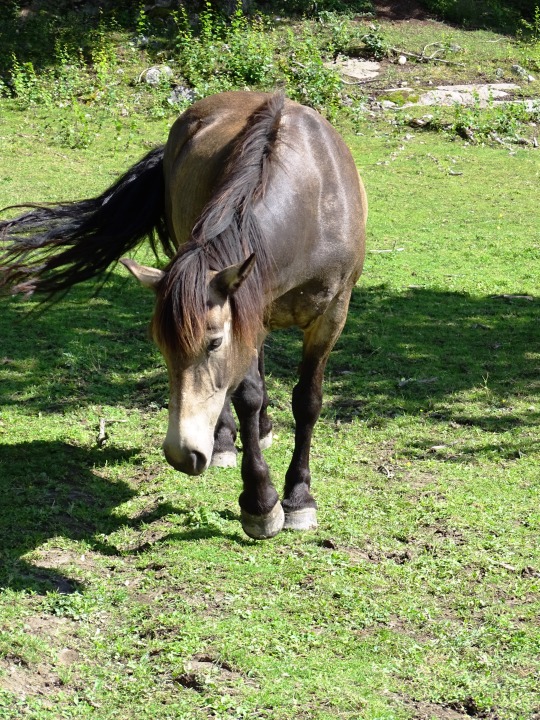



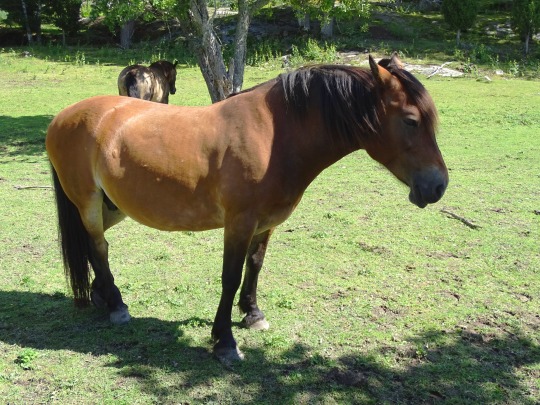
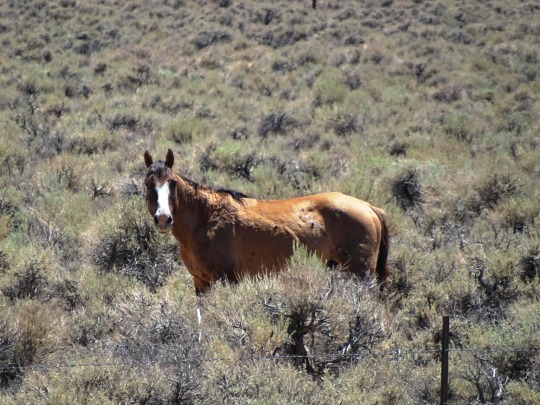

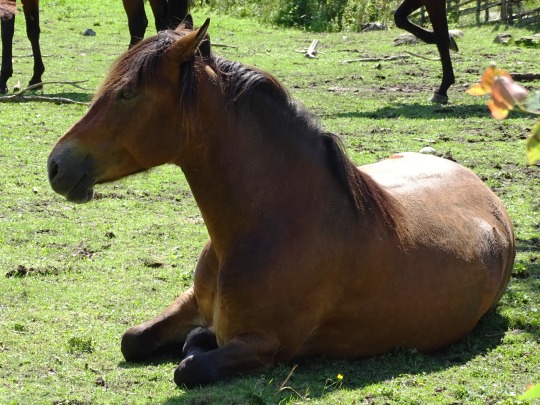



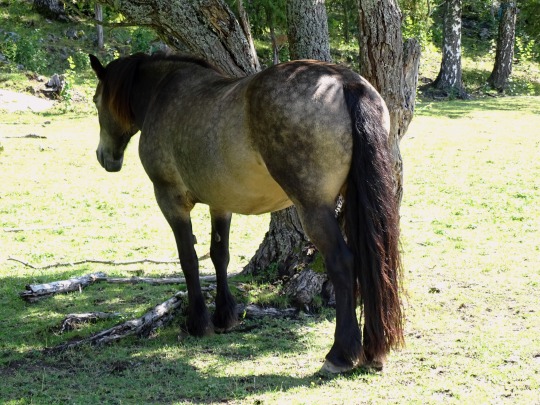

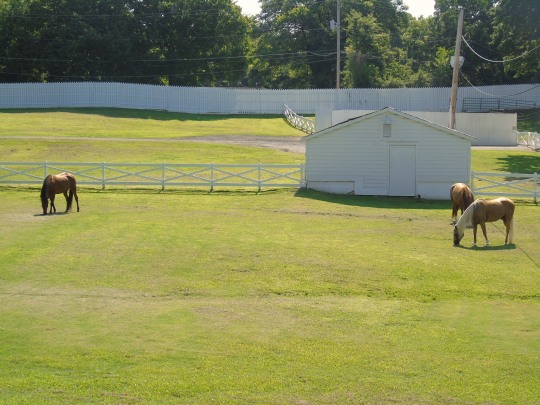
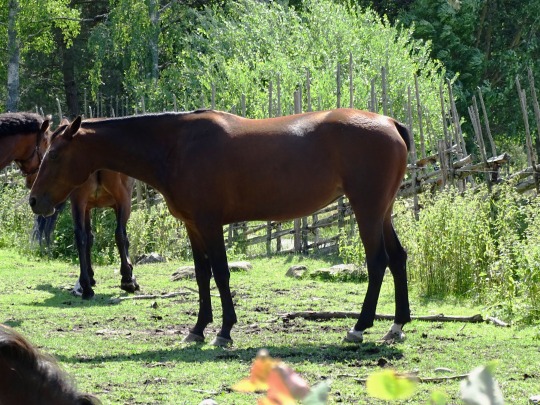



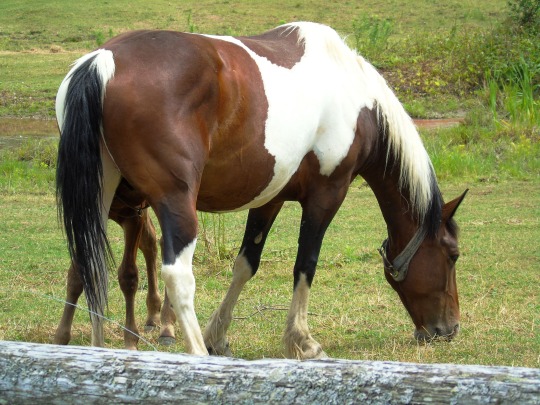
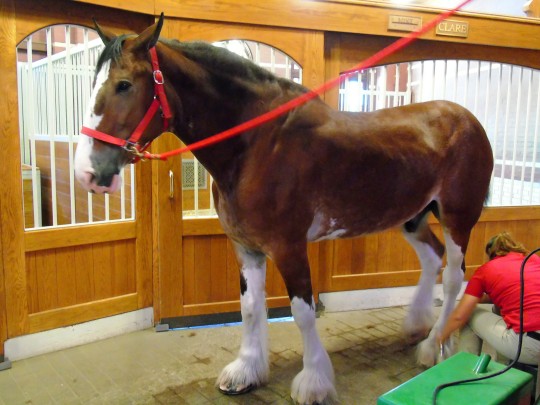
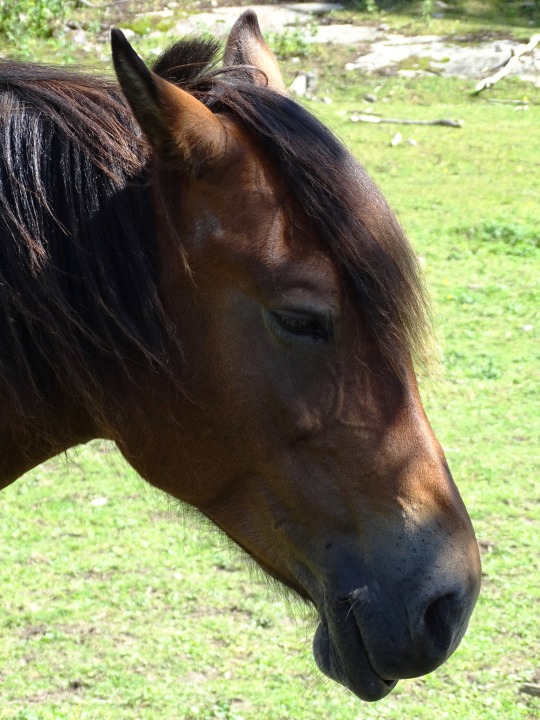
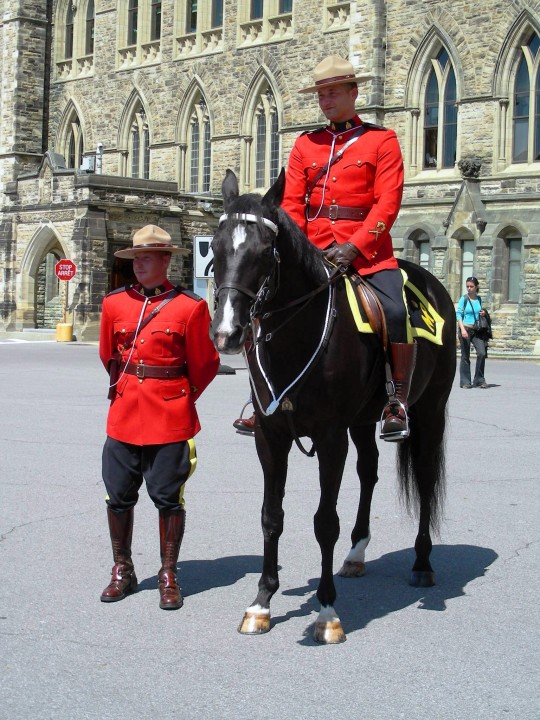
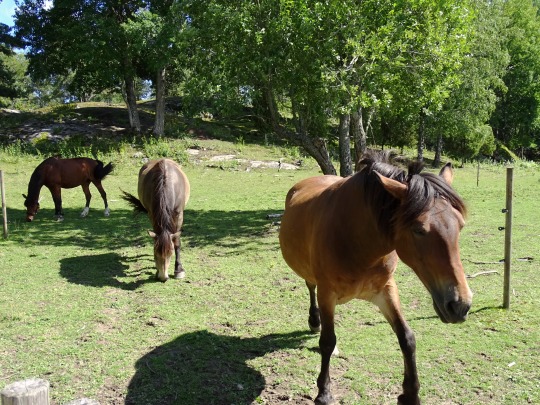

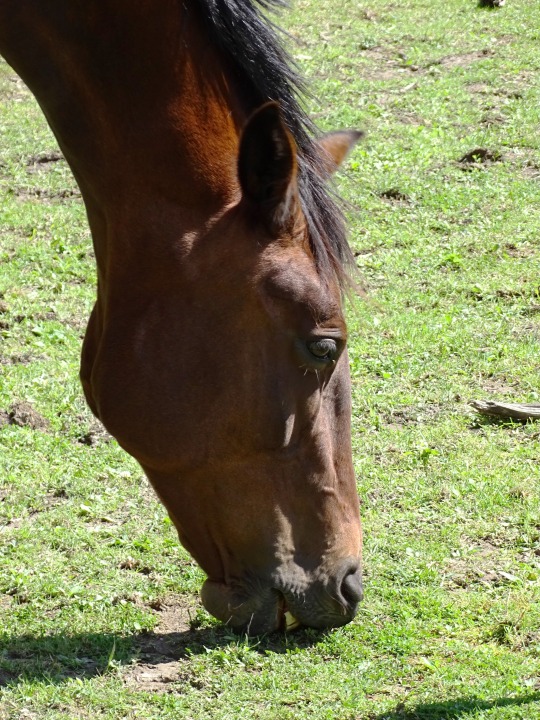

National Help A Horse Day
On of mankind’s closest companions, horses require lots of gentle, loving care to thrive, which is why horse lovers take part in National Help a Horse Day.
No horsing around – today is an opportunity for you to be a good ‘neeeiiigh-bor’ as it’s National Help A Horse Day! This important occasion aims to raise awareness of the struggles that equines all over the world face and contribute to efforts saving them from cruel and inhumane situations.
Horses are very distinctive animals, well known for their grace and beauty. While there over 300 different breeds, they can be grouped into three main types – “hot bloods”, which are fast and bold, “cold bloods”, which are strong and calm, and “warm bloods”, which are a blend of the two and tend to be good for riding.
They can be flighty animals and scare easily, which also means they’re able to sleep standing up in case a quick getaway is needed! A horse’s teeth are incredibly long and gradually emerge into the mouth (a process known as “erupting”) over the course of its life to replace what’s been ground down by chewing. And of course they’re excellent runners, able to move in a variety of gaits including trotting, cantering and full-out galloping!
History of National Help A Horse Day
Alongside the loyal dog, horses are often referred to as man’s best friend, and it’s no wonder! Over the course of human history, these majestic beasts have been the backbone of civilization and have done much of the heavy lifting in human endeavors, often literally!
Tamed around 5 millennia ago, equines have been crucial across a wide range of areas including transport, agriculture, warfare and ceremonial occasions. More recently they’ve also become a staple in the world of sport, have been used as therapy animals and, perhaps above all, have won many a heart as faithful companions.
And yet there is also a dark side to our history with horses, with mankind often treating these dedicated animals with cruelty and contempt. In recent years, stories of their neglect and abandonment have also continued to rise as some owners have found the cost of looking after them simply too much to cope with.
National Help A Horse Day was started by the American Society for the Prevention of Cruelty to Animals (ASPCA) in 2014, but its origin dates back much further to the creation of the ASPCA itself. It all started in 1863 when Henry Bergh, an American diplomat posted in Russia, saved a horse from being abused by a carriage driver. The owner responsible was arrested on 26 April that year for his mistreatment of the animal, the first time this had ever occurred, and Bergh went on to found the ASPCA in 1866. National Help A Horse Day therefore honors this significant date for the ASPCA and horses everywhere.
The society now hosts an annual Help a Horse Home Challenge to mark the occasion – the challenge is a nationwide competition for horse shelter and rescue centers, with the winners receiving a generous grant to further their work. And National Help A Horse Day has spread both in the US and internationally, with people all over the world celebrating these amazing equines and raising awareness of the cruelty and neglect they can be subject to.
Why horses need our help
Given their loyal and caring nature, it’s no surprise that horses are a popular pet. Yet due to their size and complex needs, they can be pretty expensive to care for. Sadly this leads to many horses being neglected or abandoned, sometimes by unfeeling owners but often by well-intentioned ones who simply no longer have the resources to cope. Neglected horses may lack the sustenance, shelter, medical treatment and enrichment they need for high-quality and fulfilled lives. Some may even be abandoned elsewhere and left to their own devices in a practice known as “fly-grazing”.
Pet horses are only part of the issue, however. Perhaps far more of a threat are unscrupulous breeders and dealers who churn out these animals by the dozen with only their pockets in mind and no thought for the horses’ welfare. This is why stricter animal protection laws and regulations are needed to prevent such heartless exploitation of these creatures.
Sport is another area in which horses can be maltreated – horse racing, for example, can be dangerous for the animals, with many put down if they are injured as they are then considered a mere expense. Similarly, working horses are at risk of abuse and exploitation, again by businesses determined to make a profit over all other considerations. Rescue centers and sanctuaries are therefore vital for helping horses, by saving them from harsh conditions and providing them with safe new homes.
The horse meat trade is another controversial area, with many opposed to its consumption. It’s illegal in various parts of the world, particularly the US, and over the years various concerns have been raised about the quality and source of the meat.
Wild horses are also at risk. Well-loved as a symbol of freedom, there are issues with how overpopulation is managed, with “mustangs” in the US often captured and placed in holding pens. Humane solutions are needed to ensure that wild equines can thrive as well as their domesticated counterparts.
How to celebrate National Help A Horse Day
National Help A Horse Day is your chance to make a real positive contribution to the care and protection of horses. Send a donation to an equine charity, sanctuary or rescue center of your choice or volunteer for one near you if you can spare the time! Another great way to bring about change is to sign petitions demanding better care for these faithful friends who have served us so well over the centuries.
If you come across a neglected or abandoned horse, then be sure to get in touch with a local animal welfare organization who will be able to rehabilitate and rehome it. And if you have the space and inclination, why not consider fostering or even adopting a horse yourself?
Take time out of your day to find out more about these charming creatures and the threats they face – be sure to share what you find out with family, friends, colleagues and your social media following so that many more people will be inspired to give vulnerable horses the help they need. Check out some of the many excellent horse documentaries available, such as Running Wild: The Life of Dayton O’Hyde, which follows a cowboy’s struggle to protect wild horses in the US, and Equus: Story of the Horse, which details mankind’s relationship with these animals over the years.
If you’re lucky enough to live near horses or perhaps even have a four-legged companion of your own, then National Help A Horse Day is a great opportunity to show them some extra love. Share an apple, carrot or sugar cube with a local horse you know and take them for a ride or trek (all with its owner’s permission of course!).Be sure to spread the word this National Help A Horse Day to give equines everywhere the best chance at a happy, healthy future. All they need is a helping hand (after all, most of them are already at least 10 hands high!) to enjoy a better life.
Source
#north Swedish horse#Tyresta National Park#Kings Landing Historical Settlement#Sweden#Canada#animal#travel#original photography#flora#fauna#nature#tourist attraction#Graceland#Memphis#National Help A Horse Day#NationalHelpAHorseDay#26 April#landscape#countryside#vacation#summer 2020#2015#2016#foal#USA#wild horse#Nevada#Ottawa#Mounties#RCMP
0 notes
Text
Merasmus Turns Sniper into a Kiwi [TF2 Blender] | Watch on YouTube
This is why you don't anger a wizard.
Inspired by @prajjna's Kiwi Sniper art.
And @siivekassii's suggestion of imagining Kiwi Sniper in the dancing kiwi video.
Kiwi video source is Dunedin's Orokonui Ecosanctuary, "Dancing Kiwi," circa 2016: (x)
Voice acting is Sniper voiced by John Patrick Lowrie and Merasmus voiced by Nolan North. Both from the game Team Fortress 2 by Valve.
Animated in Blender by Katy133. Composited in Kdenlive. (Ko-fi)
Thank you to hisanimations (YouTube) for the TF2 Trifecta Blender addon I used.
519 notes
·
View notes
Note
Hi! I was wondering if you knew anything in particular about the Lincoln Park Zoo- I think it’s the only zoo I’ve ever been to that’s free/no admission! Especially considering the scale. The only thing that concerned me was that their polar bears seem to have a history of stereotypical behaviors (pacing, primarily) which I saw while I was there, but again, I’m a total outsider to the actual inner workings of the facility. Sorry if this is too vague, haha.
There's a couple city zoos like that with free entrance! It's a cool option, and indicative of the city providing enough funding for the facility to operate without the need for income from tickets. (Sometimes the way things are set up, I think they can be required to stay free). The St. Louis Zoo is another!
I don't know a lot about the Lincoln Park Zoo beyond what I've seen as a guest. I've gone a couple times and haven't seen anything that stood out to me as major red flags, but that's just from a public perspective and not a comprehensive assessment. They're AZA-accredited and have been for a long time, which is an indication of their general ethos and operations. I can't speak to more than that about their quality, unfortunately.
You're right about the polar bear stereotypies - that's a thing I've seen for myself. The thing is, with stereotypies - and especially with polar bears - they're not necessarily an indicator of current welfare or quality of life.
For folk who are new to the blog or unfamiliar with the concept, in animal care, a stereotypy is a "repetitive, invariant behavior pattern with no obvious goal or function." Examples often seen are repetitive pacing, head-bobbing, licking or chewing, and rocking or swaying. (It's important to note that not all repetitive behaviors are stereotypic behaviors - e.g. animals may pace when excited and anticipating the arrival of a keeper). Stereotypies can be an indicator of chronically poor welfare, under-stimulating enrichment, or inappropriate captive environments, but the important thing to know about that is that they often persist after the problem that caused them is resolved. So you can take a polar bear or an elephant that picked up a stereotypic behavior in one zoo and move them to another, much better situation, and they may still continue the stereotypy.
(The fact that stereotypies can be indicators of previous, but not current, welfare problems is a really important nuance that is often left out of discussions. Sometimes they're called "zoochosis", which anti-captivity folk define as "the psychosis induced by captivity"... but that's a very unscientific approach, and doesn't facilitate productive discussion or attempts to identify causes and alleviate the behavior. Zoochosis is nothing but a useless manipulative buzzword, folks.)
Bears in general seem to be prone to stereotypies in captive situations. I've seen some recent research that hypothesizes it's likely due to a lack of ability to engage in normal behavioral sequences, such as foraging. Polar bears seem especially prone to it. One 2013 study found that of the 55 polar bears in North America they assessed, 85% engaged in stereotypical pacing. It might be because they natural cover such a huge range in the wild that older, smaller exhibits haven't allowed them to move as much as they need to; it could also be due to a historical lack of appropriate enrichment. We don't really know, because there's so many potential factors, and the long lifespan of polar bears means longitudinal studies of multiple generations take a very long time.
These are both things the industry is working on fixing: newer polar bear exhibits are built to be much larger and more complex, and there's been a heavy focus in the literature for at least a decade on finding ways to reduce stereotypies by providing engaging enrichment and increasing bears' activity levels. Lincoln Park Zoo's polar bear habitat was renovated in 2016, and - while it looks rather boring to me, as a guest - it was apparently designed to allow for a lot of activity range and polar bear-specific needs.
Their current bears are both about 20 years old, and were transferred to the Lincoln Park Zoo after the new habitat was completed. It's entirely plausible the bears arrived with stereotypies from their previous facilities, given that the emphasis on improving polar bear care is younger than they are. Here's a photo I took there a couple years ago, of Talini (I think), engaging in a repetitive head tossing behavior. It's definitely hard to watch, as a guest, and I don't remember if they had signage up about it.
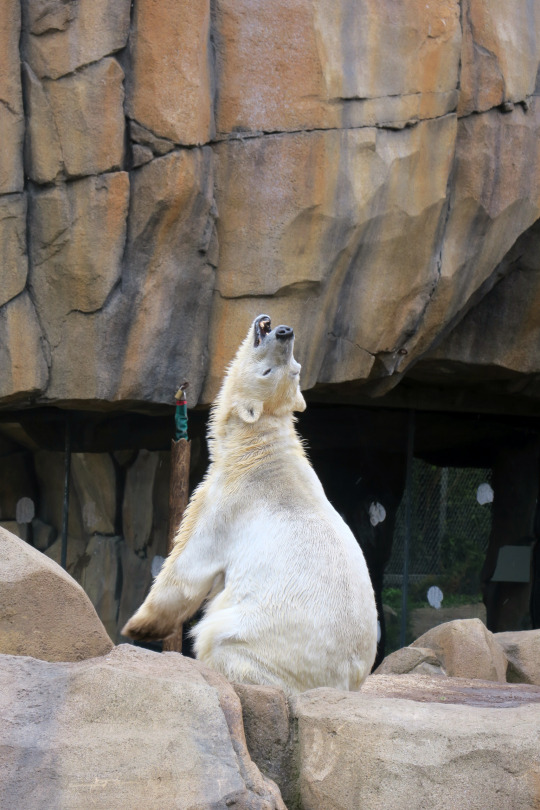
That all being said, I wouldn't judge the whole zoo based on the polar bear stereotypies, because there's so much at play there in terms of history and the evolution of care for the species. What's important is how they're handling it, and what they're doing to help encourage more normative behavior from the bears. Given the amount of research and effort the zoo field has put into addressing the topic in polar bears for the last decade, it's highly probable that a lot of staff time goes into helping reduce the amount of time those bears spend engaging in stereotypies.
272 notes
·
View notes
Text
youtube
finally watched watched my brothers and sisters in the north when it's been in my to-watch list for years and it was so touching and so beautiful.
the people interviewed were of course handpicked and have better conditions than other people because of the impact of U.S. sanctions and such, but it genuinely inspired me how hard-earned their good living conditions are. the farmers had to work really hard to re-establish agriculture after the war and now they get so much food a year they donate most of it to the state because they simply don't need it. the girl at the sewing factory loves her job and gets paid with 14 kilos of food a month on top of her wages. the water park worker is proud of his job because 20,000 of his people can come and enjoy themselves every day, and Kim Jong-un himself took part in designing it and came by at 2am during construction to make sure everything was going smoothly. his grandmother's father was a revolutionary who was executed and buried in a mass grave in seoul but in the dprk he has a memorial bust in a place of honor and his family gets a nice apartment in pyongyang for free.
imperialist propaganda always points to the kim family as a dictatorship and a cult of personality but from this docu it's so obvious that it's genuine gratitude for real work for the people, and simple korean respect. if my president came to my work and tried his best to make my working conditions better and to make my life better, i would call him a dear leader too. if my president invented machines and designed amusement parks and went to farms all over the country to improve conditions for the people, i would respect him.
the spirit of juche is in self-reliance, unity of the people, and creative adaptations to circumstances. the docu rly exemplified the ideology in things like the human and animal waste methane systems powering farmers' houses along with solar panels, how they figured out how to build tractors instead of accepting unstable foreign import relationships, and how the water park uses a geothermal heating system.
it rly made me cry at the end when the grandma and her grandson were talking about reunification. the people of the dprk live every day of their lives dreaming of reunification and working for reunification, and it's an intergenerational goal that they inherited from their parents and grandparents. the man said he was so happy to see someone from the south, and that even though reunification would have its own obstacles that we have the same blood the same language the same interests so no matter what if we have the same heart it would be okay.
and the grandma said "when reunification happens, come see me." and it's so upsetting that not even 10 years later, the state has been pushed into somewhat giving up on this hope. the dprk closed down the reunification department of the government last year and it broke my heart.
a really good pairing with the 2016 film is this 2013 interview with ambassador Thae Youngho to clarify political realities in the dprk and the ongoing U.S. hostility that has shaped the country's global image. the interviewer Carlos Martinez asks a lot of excellent questions and the interview goes into their military policy, nuclear weapons, U.S. violence and sanctions, and the dprk's historical solidarity with middle eastern countries like syria and palestine and central/south american countries like nicaragua, bolivia, and cuba.
81 notes
·
View notes
Note
hello, do you have any videos or youtube channels recs to learn more about being intersex (that touch on any topic)? if you do, tysm!
I do, thank you for asking! I apologize that many of these are not closed captioned in advance, but I've compiled a playlist of SOME videos that I've seen online.
I would like to add some clarification, though. Many forms of media that are available will use the derogatory word, "hermaphrodite", to describe intersex people. Due to its extensive history in medical pathologization, it is considered a slur and should not be used by perisex (non-intersex) people. Reclaimed usage of the term (similar to slurs reclaimed by the queer community) is only reserved for intersex people due to said history. However, medical contexts continue to use it as a diagnostic label, so many intersex people must use it when trying to receive affirming healthcare.
As a result, it's important to be aware of this information when many forms of media, both old and new, contain the usage of this word.
While the word is genuinely relevant for discussions of animal and plant biology, it does not accurately describe the anatomy of intersex people. Unlike animals and plants, human beings--whether perisex or intersex--are generally not capable of having two different sets of fully functioning reproductive anatomy. Sex (for humans) is a bimodal spectrum, and is not a binary. As such, bodies can look many different ways due to innate variations of sex characteristics!
Now, I'll highlight a few specific videos in particular below:
A 2016 TedxTalk by an important intersex scholar, Dr. Georgiann Davis. She has written dozens of extremely important publications over the past decade! Here is a 2011 publication and a 2015 publication discussing the pathological medicalization of intersex people , and a 2016 publication that additionally describes the medicalization of trans experiences.
Emily Quinn's 2018 TedxTalk and her 2018 Ted WOMEN presentation (the second one is captioned). She also has a YouTube channel!
Pidgeon Pagonis has a YouTube channel, and they have been featured in several different interviews across the years during their ongoing advocacy work. They have a 2019 documentary about their experiences, and they have a website.
Here is an archived video from 1997 of intersex people discussing their experiences with other intersex people at a gathering held by Intersex Society of North America, whose work is currently continued by interACT.
In collaboration with Human Rights Watch, interACT worked on a 2017 report and video to raise awareness of the harms of medically unnecessary surgeries performed on intersex children without fully informed consent. The video is captioned.
Activist Sean Saifa Wall has spoken extensively about his experiences on media platforms, and he is a co-founder of the Intersex Justice Project, which focuses on empowering Black and Brown intersex people in advocacy work.
There is a 90 minute documentary that was released in 2023 called Every Body, and it details the life experiences of three intersex people.
While not a video, there is also the personal experiences of intersex youth as documented in a 2023 doctoral research dissertation done in collaboration with interACT: “'Support the shit out of them:” Intersex emerging adults’ socialization experiences and recommendations for caregivers of an intersex child".
Overall, I hope this is suitable resource, and thank you again for the question!
40 notes
·
View notes
Text
The US Coast Guard’s Titan submersible hearing kicked off with a startling revelation.
“I told him I’m not getting in it,” former OceanGate engineering director Tony Nissen said to a panel of Coast Guard investigators, referring to a 2018 conversation in which CEO Stockton Rush allegedly asked Nissen to act as a pilot in an upcoming expedition to the Titanic.
“It’s the operations crew, I don’t trust them,” Nissen told the investigators. “I didn’t trust Stockton either. You can take a look at where we started when I was hired. Nothing I got was the truth.”
Nissen’s testimony, which focused on the design, building, and testing of OceanGate’s first carbon fiber submersible, was a dramatic start to nearly two weeks of public testimony in the US Coast Guard Marine Board of Investigation’s hearings into the fatal June 2023 implosion of the Titan. Its five occupants, including Rush, all likely died instantly.
Before Nissen took the stand, the Coast Guard presented a detailed timeline of OceanGate as a company, the development of the Titan submersible, and its trips to the wreck of the Titanic, resting nearly 3,800 meters down in the north Atlantic. These slides revealed new information, including over 100 instances of equipment failures and incidents on the Titan’s trips in 2021 and 2022. An animated timeline of the final few hours of the Titan also included the final text messages sent by people on the sub. One sent at about 2,400 meters depth read “all good here.” The last message, sent as the sub slowed its descent at nearly 3,400 meters, read “dropped two wts.”
The Coast Guard also confirmed reports that the experimental carbon fiber sub had been stored in an outdoor parking lot in temperatures as low as 1.4 degrees Fahrenheit (–17 Celsius) in the run-up to last year’s Titanic missions. Some engineers worried that water freezing in or near the carbon fiber could expand and cause defects in the material.
Nissen said that almost from when he joined OceanGate in 2016, Rush kept changing the company’s direction. A move to certify the vessel with an independent third party fell by the wayside, as did plans to test more scale models of the Titan’s carbon fiber hull when one failed early under pressure. Rush then downgraded titanium components to save money and time. “It was death by a thousand cuts,” Nissen recalls.
He faced tough questioning about OceanGate’s choice of carbon fiber for a hull and its reliance on a newly developed acoustic monitoring system to provide an early warning of failure. One investigator raised WIRED’s reporting that an outside expert Nissen hired to assess the acoustic system later had misgivings about Rush’s understanding of its limitations.
“Given the time and constraints we had,” Nissen said, “we did all the testing and brought in every expert we could find. We built it like an aircraft.”
Nissen walked the Coast Guard board through deep-water testing in the Bahamas in 2018, during which he says the sub was struck by lightning. Measurements on the Titan’s hull later showed that it was flexing beyond its calculated safety factor. When a pilot subsequently found a crack in the hull, Nissen said, he wouldn’t sign off on another dive. “I killed it,” he testified. “The hull is done.” Nissen was subsequently fired.
Nissen sought to draw a line in the sand between the vessel he worked on and the one that took the fateful voyage to the Titanic. The latter had a replacement hull and a redesigned acoustic monitoring system. “My design was collecting data such that we would prevent a catastrophic failure and ultimately the loss of human life,” he said. “We did that with serial 1. What they did in serial number 2, I don’t know. “
The next witness, Bonnie Carl, worked at OceanGate for less than a year between 2017 and 2018. Carl was hired as a director of human resources and finances and was also training to be a pilot for OceanGate’s submersibles. Carl said that one of the company’s board members, former Coast Guard rear admiral John Lockwood, was brought in for oversight and “to show that we’re talking to the Coast Guard.”
She also echoed Nissen’s testimony that Rush was in complete control of the company: “There might be discussion, but in the end … all decisions were made by Stockon,” she said.
The final witness of the day was an OceanGate contractor and veteran submersible operator, Tym Catterson. Catterson is one of only two witnesses the Coast Guard has called who was among the 42 people aboard the Polar Prince, OceanGate’s support ship, that June. He was operating the floating platform used to transport, launch, and recover the Titan submersible.
The preparations for the Titan’s dive that day went smoothly, said Catterson: “The sun came out, there were no red flags, and it was one of the first times we ever launched on schedule.”
He did have positive things to say about OceanGate’s safety culture, noting that Titan’s predive checklist was longer and more thorough than those used by other submersibles. But Catterson also admitted to contributing to an “uncomfortable” incident on a previous Titan dive, where an incorrectly closed valve caused the sub to tilt, tumbling its passengers together for an hour.
Catterson was able to give only a very spotty account of events following Titan’s loss of communication. He repeatedly referred the board to OceanGate’s operations director Scott Griffith as someone who could provide a more complete account of the dive. Griffiths is not on the Coast Guard’s list of witnesses, nor are any employees of OceanGate’s operations team.
Catterson was there for the recovery of some of the Titan’s wreckage, however. He testified that the inside edge of one titanium ring was sheared off all the way around. One former OceanGate engineer believes this supports the theory that the implosion was allegedly caused by damage to the carbon fiber there, perhaps from freezing water or lifting the sub without using the correct equipment, rather than a failure of the hull from pressure alone.
The hearing continues this week and next.
26 notes
·
View notes
Text
We're going to take it slow this Wet Beast Wednesday and talk about Somniosus microcephalus, the Greenland shark. Its one of the sleeper sharks, a family named for their very slow movement and generally low-activity lifestyles. Greenland sharks follow the rule that slow and steady wins the race. With a top speed of 2.6 km/h (1.6 mph), the Greenland shark has the slowest speed of its size of all fish. They also have a slow metabolism which correlates with a very long lifespan. The lifespan of these sharks isn't known for sure, but given that they grow at a rate of about 1 cm per year and can reach around 6 meters in length, they can live a pretty long time. Normal methods of aging sharks don't work on the GS. Sharks are usually aged by counting growth rings on fin rays or vertebrae, but Greenland sharks don't have fin spines and their vertebrae are too sift to form growth rings. In 2016, a paper titled "Eye Lens Radiocarbon Reveals Centuries of Longevity in the Greenland Shark (Somniosus microcephalus)" by Nielsen et al. was published that described a new aging method in which crystals in the eye lens could be radiocarbon dated to provide and age estimate. The oldest shark they tested was aged at 392 ± 120 years old. If the lifespan falls on the upper end of that range, it could give the GS a maximum age of 500 to 600 years old. The same paper also estimated that they don't reach sexual maturity until around 150 years old. The GS is officially listed as the longest-lived of all vertebrates.

It looks like somebody tried to draw a shark from memory (image: a Greenland shark swimming under ice)
The extreme age and slow lifestyle of the sharks is linked to their habitat. Despite the name, they are not only found around Greenland. In fact, they live in very cold waters (0.6 - 12 degrees C or 31 - 54 degrees F) in the north Atlantic and Arctic Oceans. They are the only shark species to live in arctic waters all year round. It is likely that they have a much larger habitat range than we know as they spend most of their time in very deep water. One specimen was found as far south as the Caribbean. It's possible that the north Atlantic and Arctic Oceans are the only places in their range that are cold enough for them to tolerate surface conditions and in the rest of their range they stay in deep, cold water. Being an ectothermic (cold-blooded) animal living in very cold conditions requires a very slow metabolism and slow metabolisms are linked to longer lifespans. A slow metabolism also requires less energy, which is very advantageous for seep-sea animals, who may be forced to go for months or longer between meals. The size of the shark may also be linked to its habitat. At up to 7 meters (23 feet) long and 1,400 kg (3090 lbs), the GS is one of the largest fish in the world. This size could be an example of deep-sea gigantism, a phenomenon in which deep-sea animals grow much larger than their shallow-water relatives. There are many proposed explanations for deep sea gigantism, including cold temperatures inducing growth (Bergmann's rule), improved foraging ability, defense against predators, and greater dissolved oxygen availability in colder and deeper waters. Because of their abyssal habitats, Greenland sharks are rarely observed in the wild and we know little about their natural behavior.
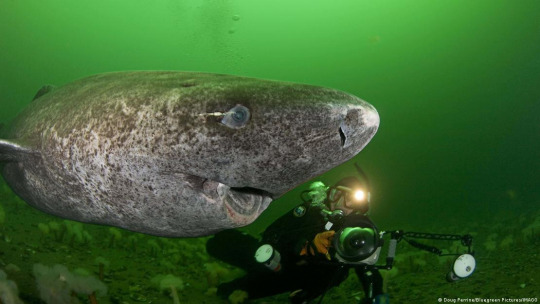
(Image: a scuba diver swimming next to a Greenland shark)
What does a large carnivore living in food-scarce deep water eat? Just about everything. Greenland sharks are generalists who will eat almost any meat. They are both scavengers and active predators, with a diet consisting primarily of squid as juveniles and fish as adults. Most of what we know about their diet comes from the stomach contents of dead specimens as they have very rarely been observed feeding in the wild. Seals also make up a large portion of their diet. As it's very unlikely that such a slow shark could chase down and catch a seal for lunch, the shark likely targets sleeping seals. Greenland sharks are scavengers who likely get a lot of nutrition from carrion. They have very sensitive noses that they use to track down rotting meat. Stomach contents have revealed meat from various animals, including polar bears, moose, and reindeer. They are known to follow fishing boats to snatch up any scraps. Greenland sharks are apex predators who play an important role in the Arctic ecosystem.

(Image: a Greenland shark captured by a fishing boat)
As mentioned above, Greenland sharks are estimated to reach sexual maturity at around 150 years old. They are ovoviviparous, meaning that the eggs hatch while still in the mother, who then gives live birth. A typical litter has around 10 pups (likely the maximum given the metabolic requirements of reproduction) that are about 38-42 cm (15-16.5 in) long. Due to their lifespan, it is estimated that a single female could produce between 200 and 700 pups during her life. Unconfirmed reports have been made of them hybridizing with other sleeper sharks.

(Image: a 100-year old juvenile shark that washed up on a beach in England)
Greenland sharks are often found infested by the parasitic copepod Ommatokoita elongata. This parasite attaches itself to the cornea of the eye and infests both the Greenland shark and the Pacific sleeper shark and dangles out of the eye like a thread. The presence of the copepod damages the eye, leaving the shark almost if not entirely blind. This doesn't actually seem to hurt the shark that much as they rely mostly on smell and hearing. One hypothesis stated that the copepod may bioluminesce to attract prey to the shark, but this remains unconfirmed.
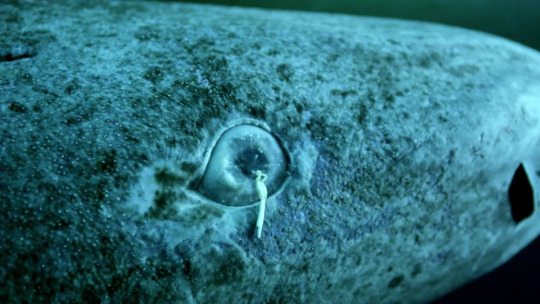
(Image: a close-up of a Greenland shark eye infested with a copepod)
Now to address the elephant seal in the room: Greenland sharks stink. All elasmobranchs have concentrations of the compounds urea and trimethylamine N-oxide (TMAO) in their bodies, but the GS has a higher concentration of these compounds than other species. The compounds are waste products retained by elasmobranchs to aid in buoyancy and the GS has more because they also help resist the pressure of the deep ocean. The concentration of urea is high enough that you can smell it if the shark is near you. Urea is a key component of urine. Greenland sharks smell like piss. The high levels of TMAO makes Greenland shark meat toxic to humans. Despite this, people still eat the meat, but it must be treated first. This can be done by boiling the meat multiple times or by fermenting it. A national dish of Iceland, kæstur hákarl, consists of Greenland shark meat that has been buried underground in gravelly sand and pressed with stones, then left to ferment for 6-12 weeks. It is then dug up and cut into strips, which are hung up and left to dry for several months. Apparently first time eaters are known to gag because of how much ammonia is in the meat. I don't think I'll try any.

(Image: hákarl hung up to dry)
Because of their deep-sea habitat, Greenland sharks have relatively few interactions with humans. In the past, They were hunted for their liver oil, but in modern days, there is no fishery for them. Greenland sharks are classified as vulnerable by the IUCN. Their primary threat is bycatch and they are likely being affected by ocean warming and loss of sea ice in the Arctic. Because of their slow maturity and low fecundity, Greenland sharks are particularly vulnerable to population loss. There are no recorded attacks on humans. The species features in the legends of the Inuit. The legendary first Greenland shark was named Skalugsuak and one story says it was born after a woman washed her hair with urine (a lice remedy) and dried it with a cloth. The cloth then blew into the ocean and turned into Skalugsuak, who still smells like urine. Another legend says that the shark lives in the urine pot of Sedna, the sea goddess, explaining its smell.

(image: scientists tagging and releasing a small Greenland shark)
#wet beast wednesday#fish#fishblr#shark#greenland shark#marine biology#marine life#ecology#zoology#ichthyology#long post#animal facts#old man that smells like pee
324 notes
·
View notes
Note
Have you seen Norm of the North, Mune, or Sahara (2017)?

Rob Schneider as a Polar Bear.
At a glance Norm of the North is easy to mistaken for adime a dozen shitty animal movie from the mid 2000s. The biggest tell that this movie was released in 2016 is instead of just having one wacky sidekick character they made Minions knockoff in the form of Norm's unintelligible hoard of lemmings.
The movie is shockingly shit as far as theatrically released movies go. People who say its the worst animated movie ever however dont know how low the discount straight to DVD basket goes.

For some reason beyond my comprehension there was a tv show that seemed to of been trying to cash in on the existance of Norm of the North.
35 notes
·
View notes
Text

SUMMARY: An American nanny is shocked that her new English family's boy is actually a life-sized doll. After she violates a list of strict rules, disturbing events make her believe that the doll is really alive.
The mod hasn't seen this movie, but had it spoiled for her so she's not really sure she wants to. Apparently, the "boy" is a hot man in the sequel so maybe she'll watch that one instead.
#the boy (2016)#thriller#doll#slasher#2010s#united states#north american movie#mentionable warning#abuse#animal death#child death#suicide#horror#movie#poll
42 notes
·
View notes
Text
In February 2024, creature enthusiasts and popular media outlets celebrated what has been described as the 200-year anniversary of the formal naming of the "first" dinosaur, Megalosaurus.
There are political implications of Megalosaurus and the creature's presentation to the public.
In 1824, the creature was named (Megalosaurus bucklandii, for Buckland, whose work had also helped popularize knowledge of the "Ice Ages"). In 1842, the creature was used as a reference when Owen first formally coined the term "Dinosauria". And in 1854, models of Megalosaurus and Iguanodon were famously displayed in exhibition at the Crystal Palace in London. (The Crystal Palace was regarded as a sort of central focal point to celebrate the power of the Empire by displaying industrial technology and environmental and cultural "riches" acquired from the colonies. It was built to house the spectacle of the "Great Exhibition" in 1851, attended by millions.)
The fame of Megalosaurus and the popularization of dinosaurs coincided at a time when Europe was contemplating new revelations and understandings of geological "deep time" and the vast scale of the distant past, learning that both humans and the planet were much older than previously known, which influenced narrativizing and historicity. (Is time linear, progressing until the Empire is at this current pinnacle, implying justified dominance over other more "primitive" people? Will Britain fall like Rome? What are the limits of the Empire in the face of vast time scales and environmental forces?) The formal disciplines of geology, paleontology, anthropology, and other sciences were being professionalized and institutionalized at this time (as Britain cemented global power, surveyed and catalogued ecosystems for administration, and interacted with perceived "primitive" peoples of India, Africa, and Australia; the mutiny against British rule in India would happen in 1857). Simultaneously, media periodicals and printed texts were becoming widely available to popular audiences. For Victorian-era Britain, stories and press reflected this anxiety about extinction, the intimidating scale of time, interaction with people of the colonies, and encounters with "beasts" and "monsters" at both the spatial and temporal edges of Empire.
---
Some stuff:
"Shaping the beast: the nineteenth-century poetics of palaeontology" (Laurence Talairach-Vielmas in European Journal of English Studies, 2013).
Fairy Tales, Natural History and Victorian Culture (Laurence Talairach-Vielmas, 2014).
"Literary Megatheriums and Loose Baggy Monsters: Paleontology and the Victorian Novel" (Gowan Dawson in Victorian Studies, 2011).
Bursting the Limits of Time: The Reconstruction of Geohistory in the Age of Revolution (Martin J.S. Rudwick, 2010).
Assembling the Dinosaur: Fossil Hunters, Tycoons, and the Making of a Spectacle (Lukas Rieppel, 2019).
Inscriptions of Nature: Geology and the Naturalization of Antiquity (Pratik Chakrabarti, 2020).
"Making Historicity: Paleontology and the Proximity of the Past in Germany, 1775-1825" (Patrick Anthony in Journal of the History of Ideas, 2021).
'"A Dim World, Where Monsters Dwell": The Spatial Time of the Sydenham Crystal Palace Dinosaur Park' (Nancy Rose Marshall in Victorian Studies, 2007).
Articulating Dinosaurs: A Political Anthropology (Brian Noble, 2016).
The Earth on Show: Fossils and the Poetics of Popular Science, 1802-1856 (Ralph O'Connor, 2007).
"Victorian Saurians: The Linguistic Prehistory of the Modern Dinosaur" (O'Connor in Journal of Victorian Culture, 2012).
"Hyena-Hunting and Byron-Bashing in the Old North: William Buckland, Geological Verse and the Radical Threat" (O'Connor in Uncommon Contexts: Encounters between Science and Literature, 1800-1914, 2013).
And some excerpts:
---
When the Crystal Palace at Sydenham opened in 1854, the extinct animal models and geological strata exhibited in its park grounds offered Victorians access to a reconstructed past - modelled there for the first time - and drastically transformed how they understood and engaged with the history of the Earth. The geological section, developed by British naturalists and modelled after and with local resources was, like the rest of the Crystal Palace, governed by a historical perspective meant to communicate the glory of Victorian Britain. The guidebook authored by Richard Owen, Geology and Inhabitants of the Ancient World, illustrates how Victorian naturalists placed nature in the service of the nation - even if those elements of nature, like the Iguanodon or the Megalosaurus, lived and died long before such human categories were established. The geological section of the Crystal Palace at Sydenham, which educated the public about the past while celebrating the scale and might of modernity, was a discursive site of exchange between past and present, but one that favoured the human present by intimating that deep time had been domesticated, corralled and commoditised by the nation’s naturalists.
Text by: Alison Laurence. "A discourse with deep time: the extinct animals of Crystal Palace Park as heritage artefacts". Science Museum Group Journal (Spring 2019). Published 1 May 2019. [All text from the article's abstract.]
---
[There was a] fundamental European 'time revolution' of the nineteenth century [...]. In the late 1850s and 1860s, Europeans are said to have experienced ‘the bottom falling out of history’, when geologists confirmed that humanity had existed for far, far longer than the approximately 6,000 years previously believed to represent the entire history [...]. ‘[S]ecular time’ became for many ‘just time, period’: the ‘empty time’ of Walter Benjamin. […] The European discovery of ‘deep time’ hastened this shift. [....] Historicism views the past as developments, trends, eras and epochs. [...] Victorians were intensely aware of ‘historical time’, experiencing themselves as inhabiting a new age of civilization. They were obsessed with history and its apparent power to explain the present […].
Text by: Laura Rademaker. “60,000 Years is not forever: ‘time revolutions’ and Indigenous pasts.” Postcolonial Studies. September 2021.
---
At the time when geology and paleontology emerged as new scientific disciplines, [...] [g]oing back to the 1802 exhibition of the first Mastodon exhibited in London’s Pall Mall, […] showmanship ruled geology and ensured its popularity and public appeal [...]. Throughout the Victorian period, [...] geology was as much - if not more - sensational than the popular romances and sensation novels of the time [...]. [T]he "rhetoric of spectacular display" (26) before the 1830s [was] developed by geological writers (James Parkinson, John Playfair, William Buckland, Gideon Mantell, Robert Blakewell), "borrowing techniques from [...] commercial exhibition" [...]. The discovery of Kirkdale Cave in December 1821 where fossils of [extinct] hyena bones were discovered along with other species (elephant, mouse, hippopotamus) led Buckland to posit that the exotic animals [...] had lived in England [...]. Thus, the year 1822 was significant as Buckland’s hyena den theory gave a glimpse of the world before the Flood. [...] [G]eology became a market in its own right, in particular with the explosion of cheaper forms of printed science [...] in cheap miscellanies and fictional miscellanies, with geological romances [...] [...] or [fantastical] tropes pervading [...], "leading to a considerable degree of conservatism in the imagery of the ancient earth" (196). By 1846 the geological romances were often reminiscent of the narrative strategies found in Arabian Nights [...].
Text by: Laurence Talairach-Vielmas. A book review published as: “Ralph O’Connor, The Earth on Show: Fossils and the Poetics of Popular Science, 1802 - 1856.” Review published by journal Miranda. Online since July 2010.
---
Dinosaurs, then, are malleable beasts. [...] [T]he constant reshaping of these popular animals has also been driven by cultural and political trends. [...] One of Britain’s first palaeontologists, Richard Owen, coined the term “Dinosauria” in 1842. The Victorians were relatively familiar with reptile fossils [...] [b]ut Owen's coinage brought a group of the most mysterious discoveries under one umbrella. [...] When attempting to rise to the top of British science, it helped to have the media on your side. Owen’s friendship with both Charles Dickens and William Makepeace Thackeray led to fond name-dropping by both novelists. Dickens’s Bleak House famously begins by imagining a Megalosaurus, one of Owen’s original dinosaurs. Both novelists even compared their own writing process to Owen’s palaeontological techniques. In the scientific community, Owen’s dinosaur research was first [criticized] by his [...] rival, Gideon Mantell, a surgeon and the describer of the Iguanodon. [...] Naming dinosaurs was a powerful way of claiming ownership [...]. Owen [...] knew the power of the press [...]. [M]useum exhibits [often] [...] flattered white patrons [...] by placing them at the apex of modernity. [...] Owen would not have been surprised to learn that the reconstruction of dinosaur bones is still an act that is entangled in politics.
Text by: Richard Fallon. "Our image of dinosaurs was shaped by Victorian popularity contests". The Conversation. 31 January 2020.
#abolition#ecology#paleo#imperial dinosaurs#victorian and edwardian popular culture#opacity and fugitivity
35 notes
·
View notes
Text
An Unexpected Norse Detail in Winterfell
I was scrolling through tumblr yesterday, as you do, and suddenly paused on a gifset of the Lannister party in Winterfell during the early episodes of season 1. What caught my eye was this:

Behind the long table in Winterfell's great hall is some kind of large wooden screen/divider featuring some very interesting carvings. These carvings are near identical to those found on the Urnes Stave Church in western Norway, which dates from the 12th century:
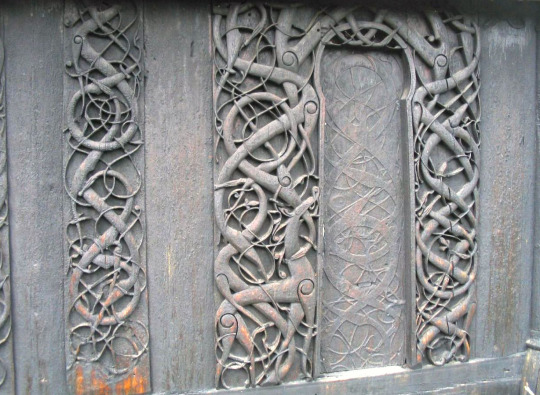
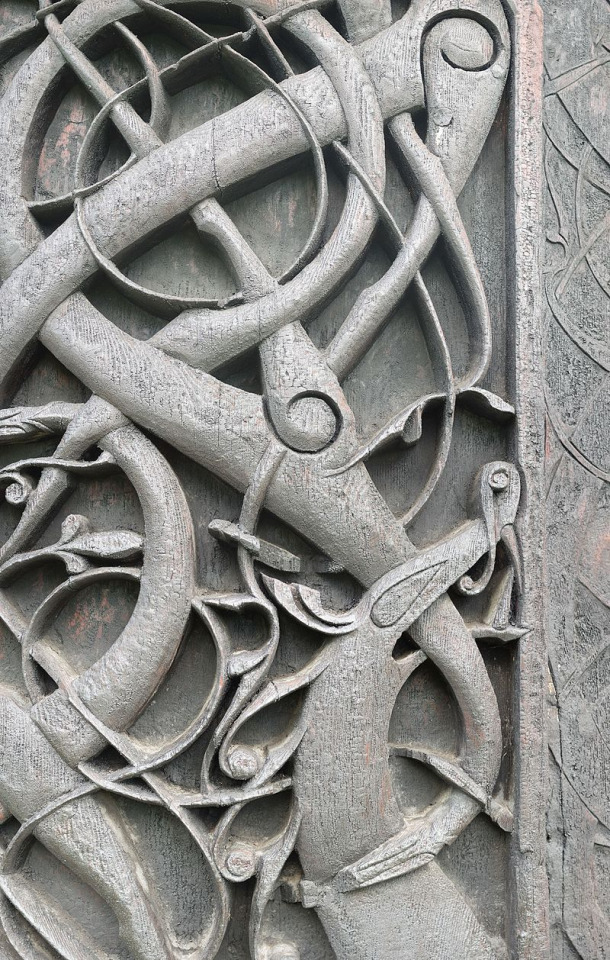
I don't think we ever see this wooden screen in Winterfell again, but it's an interesting inclusion nonetheless, back when the show stuck more closely to the source material.
In The Vikings (Penguin, revised edition, 2016) Else Roesdahl talks a bit about this particular style of ornamentation:
The Urnes style is the last phase of the long development of Scandinavian animal ornament. This seems to have developed shortly before the middle of the eleventh century and was popular for nearly a century, that is into the early Middle Ages. After a final phase where it gave rise to details and influences in Romanesque art, now predominant in Scandinavia, it had died out completely before the year 1200. Many other forms of Viking Age followed the same course.
The vigour and vitality of the Ringerike style gave way to this sophisticated, elegant, indeed almost decadent, style. It is named after the exquisite wood carvings that were re-used in Urnes Church in western Norway: a portal and a door, two wall planks, a corner post and two gable ends, one complete [...] The large, four-legged animal is still one of the main motifs, but it has become as slim as a greyhound. Snake-like animals with one foreleg, snakes and thin tendrils sometimes ending in a snake's head are also featured. The designs characteristic of this style form open, asymetric patterns, creating an impression of an undulating interweaving of animals and snakes. The large loops are often figures-of-eight and the shapes grow and diminish evenly; there are no abrupt transitions. The style is also used with virtuosity on brooches and on large numbers of rune stones in central Sweden, where the undulating ornament follows the shape of the stone and the long bodies of the snakes are used as rune bands [...] Several examples of the style have been found in England, and in Ireland it became as popular as the Ringerike style.
What's so intriguing about the original carving though is that it is depicting pagan symbolism... but on a Christian church. As mentioned above, the Ringerike style predate Urnes and was "roughly contemporary with the intial spread within Scandinavia of Christianity, and was the first to contain Christian iconography, although pagan symbolism was still present," notes Philip Parker (The Northmen's Fury, Vintage, 2014). By around 1050, it gave way to the Urnes style, named for the stave church shown above.
But what do these carvings mean? In Tree of Salvation: Yggdrasil and the Cross in the North (Oxford University Press, 2013), G. Ronald Murphy offers this explanation:
The door is simply surrounded with whorls of writhing snakes and vines. The tangle is so perfectly executed in a welter of animal elongation and plant reduction to vines, that it is difficult to identify where a head begins or where a tail finally ends, if at all, or to trace what seems like a joint to a neck or a leg or a vine. The main point seems to be the inter-twined-ness itself of all living things, animal or vegetable, in one huge tangle [...]
Now as one looks at the left side of the doorway there is one animal standing on four legs [see above!] that is simply startling in the clarity of its depiction. It has been called a lion and explained as the Lion of Judah (Christ) fighting with evil. I think that such an interpretation makes the mistake of using an inappropriately biblical explanation when the artist, by his very Viking-like pictorial style as well as his tangle of animal and plants, tells you he is here using a Germanic one.
If you look at the animal you can see that he is eating at the vine or branch which in turn is a serpent biting at him in the neck. Look at the animal's head and you can see two small horns protruding—that animal is a young male deer, a hart. Now it becomes clear it is not the Old Testament that is giving the context here for the meaning of the portal: this is an allusion to the Elder Edda and its description of Yggsdrasill as the suffering tree with many serpents forever biting on its twigs and branches, as those twigs and branches are also being devoured by a hart. The traditiona of the single deer may also come from a previous stanza in the Grímnismál where the hart is named:
Eikþyrnir [Oak-thorn] is the hart's name, who stands on Father of Hosts' hall
and grazes Læraðr's [kenning for Yggdrasill] branches;
and from his horns liquid drips into Hvergelmir [seething cauldron],
from thence all waters have their flowing (Poetic Edda 55 and 270n)
According to Murphy, "to enter the door of the Urnes stave church is to enter Yggdrasill." So, to bring this back to the world of asoiaf, it´s an interesting piece of set design to include this screen or divider in Winterfell, a place closely connected with the "old gods" of the north and that has its own world tree, in a sense: the weirwood tree, or heart tree, of the godswood. Moreover, beneath one of Yggdrasill's three large roots is the spring Hvergelmir (mentioned above, meaning 'seething cauldron'), beneath another is Mímisbrunnr ('Mímir's well) and beneath the third is Urðarbrunnr ('Well of Urðr'), this is interesting to note in parallel to the hots springs and ice-lidded pool in Winterfell's godswood, close to its heart tree.
In the Prose Edda, one of our foremost sources on Norse mythology, Yggsdrasill is also connected with Ragnarök, the doom of the gods. In chapter 54, it is told that Óðinn will ride to the well Mímisbrunnr and consult Mímir on behalf of himself and his people. After this, "the ash Yggdrasill will shake and nothing will be unafraid in heaven or on earth," and then the Æsir and Einherjar will don their war gear and advance to the field of Vígríðr. In asoiaf, the north has its own legend very reminiscent of Ragnarök, called the Long Night and I've written about their similiarities before and keep meaning to return to that.
Anyway, I just think it's pretty cool they included that detail of the Urnes style screen in Winterfell — I'm always putting Norse details into my fics wherever I can, most recently the Oseberg tapestry.
#cappy's thoughts#yggdrasil and the heart tree#winterfell#historial influences in got and asoiaf#asoiaf and norse mythology#IT IS THE SAME DESIGN i can't believe i never noticed it before?
58 notes
·
View notes
Text




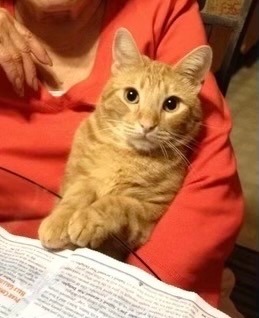
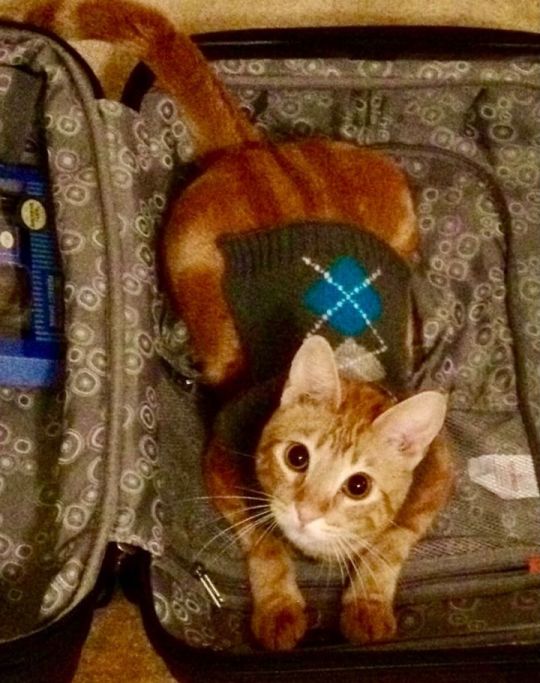
Micho from Mad Love Animal Rescue in North Hollywood, California
Click here for more information about adoption and other ways to help!
Click here for a link to Mad Love Animal Rescue's main website.
Micho is a small 7.5-pound 8 year old orange tabby cat. He was adopted in 2016 from a shelter when he was a kitten, and since then he has lived with the families grandmother and has been one of her best friends.
Unfortunately, due to her age (she's 93 now), she is no longer able to take care of him. The family member that took him in has issues with not having enough time, and allergies as well. We are in desperate need to find Micho a new loving home.
He is very loving and cuddly. He loves to sit up against you and rest and purr’s to let you know what a happy guy he iis. He is very interactive, meowing and looking at you in the face with cute big eyes (think pus-n-boots in Shrek) when he wants to communicate something. He can get anxious in new environments but once he gets used to it (usually takes a day or two), he warms up quickly and acts more like himself. If interest in this gorgeous hunk of love please let us know ;)
23 notes
·
View notes
Text
September 2024 Birthdays | Sunday, 09.01.24
Here are the upcoming birthdays in the month of September 2024 down below:
Sunday, September 1
Dave Wittenberg (voice of Kakashi Katake in the English dub of the Naruto anime and its video game tie-ins since 2005)
Monday, September 2
Faye Mata (voice of Aqua in Konosuba: God's Blessing on this Wonderful World! and Ling Xiaoyu in Tekken: Bloodline)
Keanu Reeves (official voice of Shadow the Hedgehog in Sonic the Hedgehog 3 (2024 movie) premiering on Friday, December 20, 2024 in North America)
Tuesday, September 3
Khoi Dao (25th birthday coming soon) (voiced Mauro Abelard in the 2021 video game, Shadowverse: Champion's Battle, which is based on the 2020 anime of the same name)
R. Bruce Elliot (current voice of Captain Ginyu since the 2010 release of Dragon Ball Z Kai through Funimation)
Wednesday, September 4
John DiMiaggio (voiced Bender in Futurama, Bobo Haha in Generator Rex, and Jake the Dog from Adventure Time)
Morgan Lauré Garrett (voiced Shiki Misaki in The World Ends With You: The Animation and Nadeshiko Kagamihara in Laid-Back Camp)
Thursday, September 5
Max Mittelman (voice of Saitama in One-Punch Man)
Friday, September 6
Idris Elba (voiced Knuckles the Echidna in both the Sonic live-action movies since Sonic the Hedgehog 2 (2022 movie) and Knuckles the Series)
Robin Atkin Downes (voiced Gary in Regular Show and Emperor Nefarious in Ratchet & Clank: Rift Apart)
Tuesday, September 10
Amanda Celine Miller (voiced MAGES. in Hyperdimension Neptunia Victory in 2013 exclusively for the PlayStation 3 console)
Thursday, September 12
Shelby Lindley (voice of Tsumugi Kotobuki in K-On!)
Friday, September 13 (Friday the 13th)
J.G. Quintel (creator and voice of both Mordecai and High Five Ghost in Regular Show)
Sunday, September 15
Ben Schwartz (voiced Dewey Duck in DuckTales (2017 TV series), Leonardo in Rise of the Teenage Mutant Ninja Turtles, and Sonic in the Sonic the Hedgehog movie series since 2020)
Colleen O'Shaughnessey (voiced Jazz Fenton in Danny Phantom and both Miles "Tails" Prower (since 2014; replacing Kate Higgins) and Charmy Bee (since 2010) in the Sonic the Hedgehog video games)
Scott McNeil (voiced Wolverine in X-Men: Evolution, Guts Man in the English dub of Mega Man NT Warrior, and Voltar in League of Super Evil)
Tuesday, September 17
Charles Martinet (voice actor; former voice of Mario, Luigi, Wario, Waluigi, Baby Mario, Baby Luigi, and Toadsworth in most of the Super Mario games between 1992 and 2022) (succeeded by Kevin Afghani starting with both Super Mario Bros. Wonder and WarioWare: Move It! and onward since 2023)
Friday, September 20
Sarah Natochenny (voiced Ash Ketchum in the English dub of the Pokemon anime between 2006 through 2023; replacing Veronica Taylor)
Saturday, September 21
Erin Fitzgerald (former voice of Noire/Black Heart in the Hyperdimension Neptunia video game series between 2011 through 2016; replaced by Erica Mendez since the 2017 release of Cyberdimension Neptunia: 4 Goddesses Online due to complications with the SAG Contracts at the time)
Sunday, September 22
Michelle Ruff (voiced Tsukasa Hiiragi in the English dub of Lucky Star and Crimson Viper in Street Fighter 4)
Wayne Grayson (50th birthday coming soon; voiced Michelangelo in Teenage Mutant Ninja Turtles (2003 TV series) between 2003 through 2009)
Wednesday, September 25
Mark Hamill (voiced Skips/Walks in Regular Show between 2010 through 2017)
Friday, September 27
Alicyn Packard (45th birthday coming soon; voiced Mistress Death in Marvel vs. Capcom: Infinite and Hinaichi in the English dub of The Vampire Dies in No Time)
Debi Derryberry (voiced Jimmy Neutron in Jimmy Neutron: Boy Genius and formerly Coco Bandicoot in several Crash Bandicoot video games between 2001 and 2021)
Jad Saxton (45th birthday coming soon; voiced Itsuka Kendo in the English dub of My Hero Academia and Chika Fujiwara in the English dub of Kaguya-sama: Love is War)
#alicyn packard#ben schwartz#charles martinet#colleen o’shaughnessey#debi derryberry#erin fitzgerald#faye mata#idris elba#j.g. quintel#jad saxton#john dimaggio#keanu reeves#khoi dao#mark hamill#max mittelman#michelle ruff#month of september#morgan lauré garrett#robin atkin downes#sarah natochenny#september 1st#september 2024#shelby lindley#sunday stuff#tara sands#upcoming#upcoming birthdays#voice talents#wayne grayson
7 notes
·
View notes